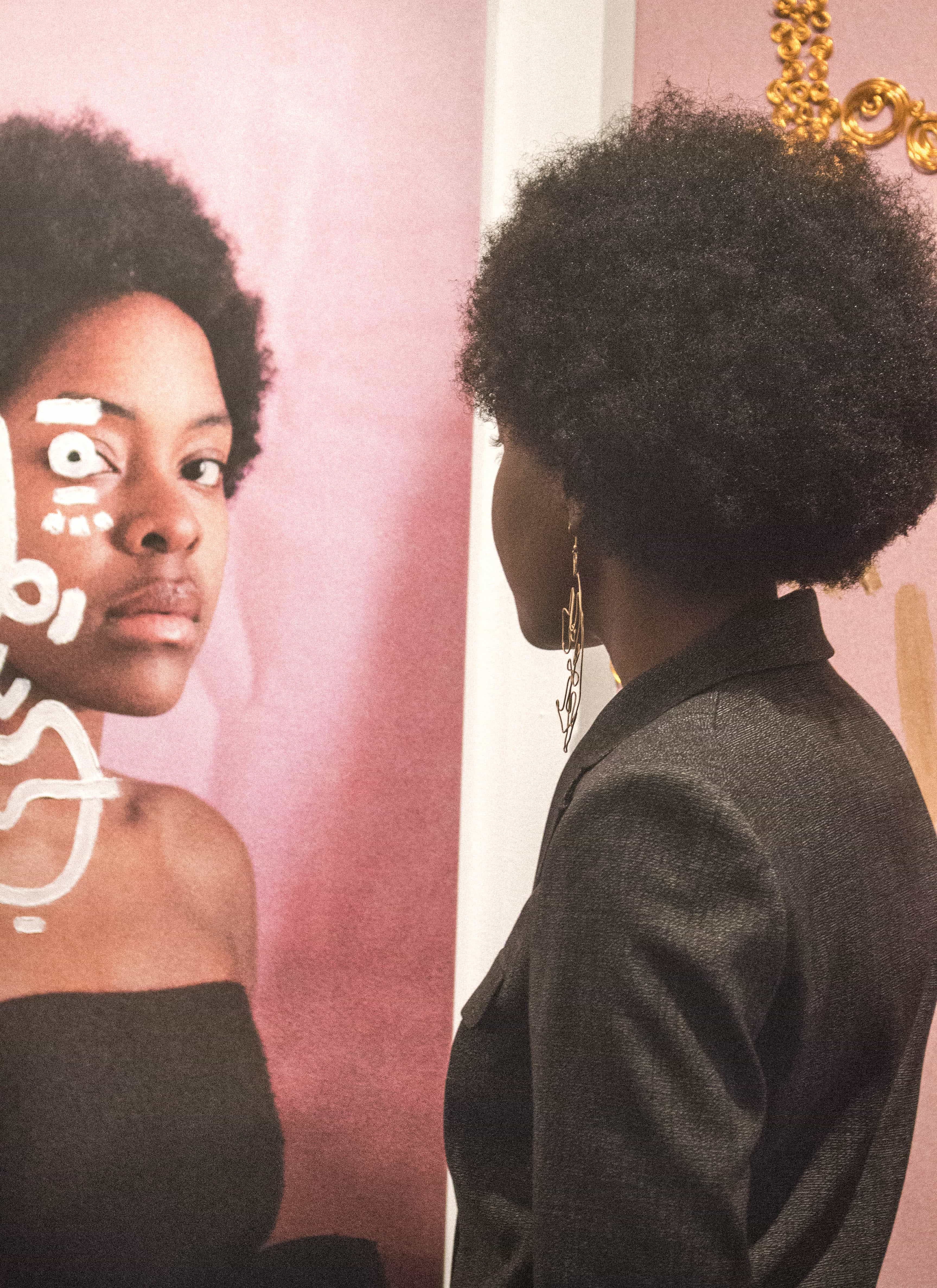“There is clearly no lack of important artistry coming out of Montreal’s Black communities, but rather a lack of resourced spaces and opportunities.” [From the project statement]
“Symbols of Resistance: an Exhibition Celebrating the Convergence of Black Artists and their Stories” opened on the first day of Black History Month, and will be on display at Galerie Mile-End until February 28. The exhibition is the culmination of the Montreal Black Artists-in-Community Residency, a twelve week residency created in response to the lack of spaces and opportunities for Black artists to make and showcase their work. The residency provided space for eight Black artists to develop work centred on Black identity, to engage with, and to create for and with their communities. The artists interweave their own personal stories with the histories of their communities and ancestors. The theme of resistance was common to all of the artists: resistance expressed through the everyday and ordinary aspects of Black life, self-care, hair-care, textiles, and head wraps. These artists centred their work around Black identity by reclaiming history from erasure and (re)creating their own archives.
At the vernissage on February 1, we heard from Annick MF — one of the organizers — and from all of the artists about their work. We welcome you into the magic of the evening through their words below.
Annick: For those of you that don’t know, this was an exhibition that came out of a 12 week residency, and the goal is to also take this artwork on tour for a year. One of the things that we felt is that often these conversations are only held around Black History Month, like “Oh, this is the nice time to talk about Black folks,” and then it’s like, “Oh, they just don’t exist anymore.” So we want to make sure that this conversation goes on further, and that Black artists have opportunities long term, so we’re trying to take this artwork on tour. If you know anyone who wants some art and has money [laughter], they can holla at us. Also, we invite you to come to the Finissage which is going to be on Monday the 26th. Come back to the space to close the ceremony with us! I also want to mention that a lot of the artists in the space decided to use new mediums. And that was one of the most interesting experiences for us as organizers of the residency — to know how much work goes behind these artworks that we see. I think sometimes we come into an exhibition and think, “Oh wow, this is really beautiful!” But we miss the amount of hours and hours of conceptual and literal physical work prior that comes into that. How much work goes into the process of even just picking a medium, like is wood the best medium, is canvas the best medium? A lot of care and attention was put into that. All of these artists worked together and in parallel to make this project come together and we’re really proud of them and really excited for you to be here experiencing this, and you’re going to meet the artists right now!
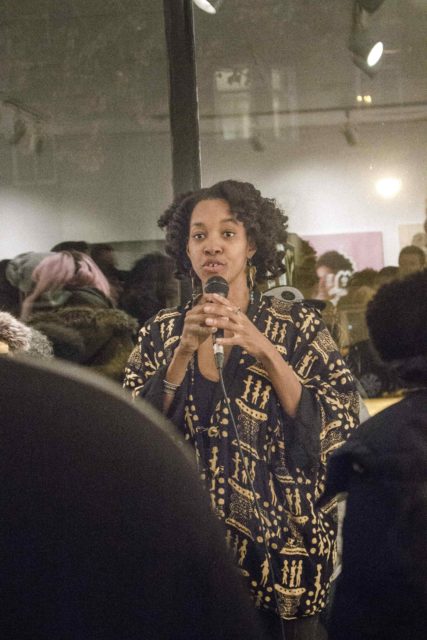
Reclaiming my time space: G L O W Z I
G L O W Z I : My piece is called Reclaiming my time space, and what I wanted to represent is the idea that even though we’re not Beyonce, or people who are victims of police brutality directly, such as Trayvon Martin, we’re still important, our experiences are still important. So the idea with my piece was to reclaim the space of ordinary Black folks, because I feel like when we look at the media we have this pressure to be like, “Okay, so now I see Beyonce and Kendrick so now I have to do something.” And you’re in your room, which is all messed up, and you’re like, “I’m not going to be Beyonce, but I’m not quite like other people I see in the media, so where am I?” So the idea was just to remind Black people while they look at the piece that no matter what they’re doing, they’re symbols of resistance. Because just going to school, just having a job, just following your dream is something that is pretty hard to do here in a system that doesn’t necessarily want you to be able to do that.
Audience member: Why particularly self-portraits?
G L O W Z I: It comes from a story where my mom always told me, “You’re a canvas and you can model yourself however you want.” And it seems like it has just followed me all my life, because I keep changing styles, changing the way I look. And I keep using my face or my body as a medium of art. So, I would say that it’s pretty much that the first canvas that you will have — and that you will have until you die — is your body, so why not use it?
Audience member: Why do you use the golden metal wires in your work?
G L O W Z I : The golden wires represent the idea that on a regular basis, we are still slaying. We don’t need to be walking in the halftime show like Beyonce to be doing amazing stuff and to be slaying. I see Black people slaying everywhere, I see them right now! [laughter] And also using metal, there’s the idea that it’s resistant but it also knows how to move. It’s the idea that even though it’s hard to move it, it can still move around and change shapes, just like Black people change their way of acting in order to cope with what we’re being exposed to.
Natural: Kay Nau
Kay Nau: About my piece — instead of talking about the symbols and all that, I’m going to talk about the stylistic choices I made, which is comic art. All my life I’ve been told that comic art is not art, by teachers, by people. So at first, when I got this residency, I was like, I’m going to do realistic renderings, because that’s what I’m used to seeing in galleries and what my teachers always tell me, “This is what art is.” And then I was like, “Nah.” [laughter] “Nah, screw this, I’m going to go with what I normally do for myself.” And it’s kind of like a little slap in the face of, you know, me being a little sassy and being like, “This is comic art and it’s on the wall of a gallery now.” And that’s kind of awesome!
Audience member: Was there a choice for the really striking red and blue?
Kay: Yeah, actually. Red and blue is not only the colour of the Haitian flag, blue is also the colour of the Quebec flag, red is the colour of the Canadian flag, it’s also the colour of France and England’s flags, which are colonizers not only of Haiti but also of Canada and Quebec.
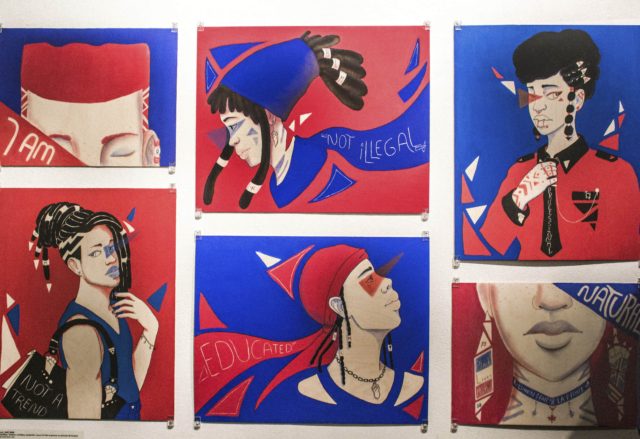
Montreal, 1985: Po B.K. Lomami, Carl-Philippe Simonise, Valerie Bah
Po: We noticed that there isn’t a lot of Black representation in the public archives from the eighties. We started from that fact, like, there were Black people in Montreal in the eighties, like obviously, but they aren’t in the public archives. So from that we started to think, “Okay, we can find those archives.” We started to ask questions like, “What about personal archives?” And that’s where we started finding a lot of answers, like people opening their personal albums to show us what it was like in the eighties. From all that research, we decided to create our own archive with all the information we have, all the research we did. And also with our own experience, including the fact that we were wondering, “Where are Black queer people in the archives?” And they are nowhere. We went to Archives Gaies du Quebec and we couldn’t even find them there. So we were like okay from my own experience, queer Black people, they’re kind of everywhere. Like, even if you go to church, we’re fucking everywhere [laughter]. From that we were like, okay, let’s restage a scene from the eighties, ’85 in particular, with all the information we have or we want to recreate. I think we can connect to Black struggles throughout history, like it’s always the same questions asked again, the same issues. Nothing is new, it’s just new vocabulary. It’s the same discussions, the same questions. So from that we started to do that for the art piece, just starting in an apartment that was built in the thirties in Côte-des-Neiges, which is like, I don’t want to say a non-white neighbourhood, but like, white people are not the majority there. Then we went to Balattou, which is a club that was created in the eighties or so, and from there we started a scenario, a story-board, with what could be Black activists talking and Black activists gathering. But not just about the struggles, it’s also about enjoying life, having a romance, just being people that have struggles sometimes but are still people. And they’re there because we can’t find them in public archives so we needed to make them visible with our own research and imaginaries, so we intertwined the archives with Afrofuturism and our own perspective. So we end up with our photo series, made in the apartment in Côte-des-Neiges and then in Balattou — we want to thank Papa Touré who opened the Balattou for us on Monday night, a really cold one, just for us to do the photoshoot. There’s also a personal photo album and a zine that includes the dialogue of what could be a discussion among Black people in Montreal in 1985, discussing about politics, or about wanting to flirt with somebody, or just having a life.
Valerie: It was very important to us, in staging Black folks in the archives, not to try and establish our place in this empire, this white settler project on unceded land. So the discussion in the actual scenario is of the activists arguing and disagreeing about Black liberation struggles around the world, and it ties back to their condition in Montreal.
Po: Yeah, you should read the zine, there’s drama and everything.
Audience member: Did you use technology from ’85?
Carl-Philippe: A budget from ’85. [laughter]
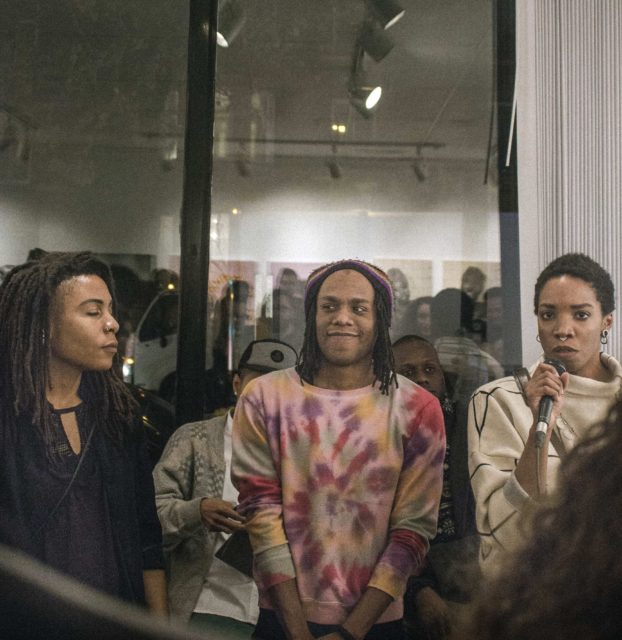
Sisterhood, Crown, Vasso: Aïssatou Diallo
Aïssatou Diallo: (translated from French) My name is Aïssatou Diallo and I am originally from Guinea. I have been drawing and creating art for the past ten years, and I started doing digital graphic design two years ago. I made the three pieces there, the first is called Sisterhood, the second is Crown, and the third is Vasso. This concept was not what I originally planned to do; there were many modifications during the process. But in the end, that, the art, is me. I am comfortable with and feel liberated using the medium of digital art because it is involved with my work. My main idea is to express who I am as an individual, but also express codes that represent the symbols of resistance. You can see these codes by what you wear, your hair, these things, and so my pieces are made by you and are visible to everyone. My pieces are not only a claim of the symbols of resistance, but also show how we share culture. I am looking for an answer to these questions and interrogations of resistance and this is what I expressed in my three pieces. For the first piece, I show that you must know yourself and others in order to share culture. It’s based on a photograph I took of a woman’s back, I was asked if the two women are the same person, and I am leaving that up to interpretation, but the idea behind the piece is “Watch your back” and “I gotchu” as well. The second shows that you must be proud of who we are, where we come from, and that it is important to share these different sides of us with other people. The third shows a mother and child, and it is also essential to show how we pass down and share ideas with the children of the next generation. We explain what it means to be a woman, and especially what it means to be a Black woman from Africa, and so on.
Baggage & Navigation, Stretched Strength, In the Search of Home: SIKA
SIKA: (translated from French) My works here are essentially an introspective exploration based on an emotional congestion that I carry around like every other person in society. I decided to visit this congestion again through three different dimensions: emotional, physical, and spiritual. I wanted to make visual material to combine with another project of mine involving musical expression. I wanted to mix the disciplines of both projects together. I wanted to reflect the presence of Black artists in Montreal, to see how this has affected me, and what carries me forward. I wanted to develop a new technique and explore unfamiliar methods for this specific piece. I benefited from working with a new palette: shades of blue. I also wanted to generate content about the strength and endurance of the Black community. I wanted to show our views, values, and marginality in society. I felt the need to create, so I benefited from the residency. It strengthened my work and formed it into an introspective scan I used to inspect the facets of my reality and my identity.
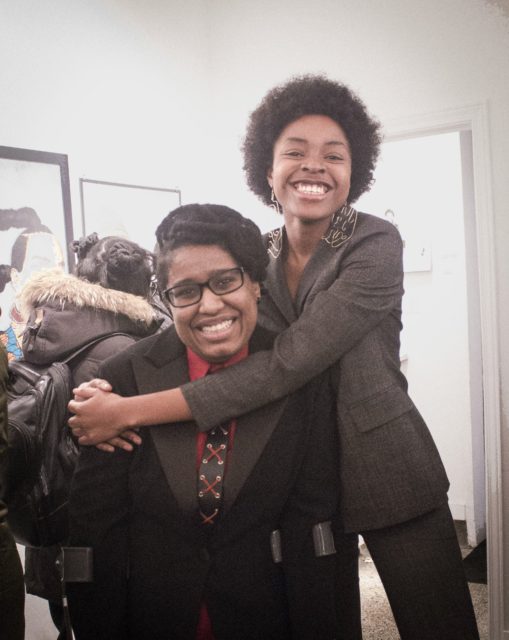
Crowning: Chelsy Monie
Chelsy Monie: Hi everybody. I’m very nervous, I don’t know what to say. My work Crowning focuses on the headwrap and just trying to take back all the histories and all the places the headwrap has been. Initially I knew I wanted to work with headwraps, and I knew I wanted to work with history and location, but I didn’t know how to translate that into my work. So I did a lot of research and I spent a lot of time looking at maps and thinking about the idea of mapping. What I ended up doing is using topographic maps, which are maps where lines and curves are used to represent the reliefs on land, which means mountains, rivers, hills — all represented by lines, which is what you can see in my work. What this allows you to do is to read the headwrap as showing a location that is in space and time and this is only emphasised by the grid, or lines of longitude and latitude. I’m really trying to have the real question of how we can look at space, not only as places we may walk through but we can look at space through the clothes that we wore, through the things that we did in those spaces. I used wood because, based on the histories and based on what I found out, headwraps are so tied to Black bodies and wood is a natural fiber, so to me, the way I see it is headwraps are in a sense natural to the Black body. That’s what the wood is there to represent. As you can see in the images my eyes are blacked out, and as much as that’s because that looks really cool [laughter] it’s also because I want viewers, other Black people looking at my art to see themselves within it. Blacking out my eyes really removes my soul from the art, right now it’s a canvas for you to look at and see yourself in any given space and time. My work necessarily is very involved with Black identity and I really want to show the Black reality as something that is artistic and something that is specific to us, so I like to take things that Black people do every day and they think, yeah, this is just us, and project it and put them in spaces like these where people can actually come and visualise them in a different way. In part of my work I am doing multiple, multiple things and one of them is I wear a headwrap everyday for this month. This was really to question my relationship with headwraps, because usually I find myself wearing headwraps when it looks nice or I don’t wanna do my hair. But what I’m really wondering is how will my relationship with my body, as well as headwraps and time and space, change when I wear a headwrap every single day. And today is a lot! [laughter] This is my headwrap for today, tomorrow I’m going to leave my house and have to wear another one, and go on and on. I’m really interested to see what it is that happens to me and how I perceive myself and also perceive headwraps. I grew up in Cameroon and then in Tanzania, and women all around me wore headwraps. I grew up with my mom going to church on Sunday and she would always have a headwrap, but I never thought of it as anything more than that. I think wearing a headwrap every single day really pushes me to see beyond that. Another part of this project is I have collaborated with photographers around the world to bring actual representations of headwraps to you. What the photographers have done is they have taken pictures of people in headwraps in the spaces they navigate. That’s what I want to share with everybody, because headwraps, like I said earlier, are natural to the Black body, and it’s very interesting how, though we live on many different continents and many different countries, we can still be identified by this one singular thing. The last part of Crowning is on the 28th of February. I am inviting Black people everywhere to wear headwraps. I think this is really a mark of solidarity and also helps us to connect to all the histories we may not necessarily connect with on a daily basis. This is really a chance for everybody to decide that okay, today we’re going to stand up and celebrate this one thing we think maybe is just a mundane thing we shouldn’t pay attention to. I am circulating two hashtags because you know, I’m a millennial, it’s 2018. [laughter] So the hashtags are #UbuntiCrowning and #UbuntuTalks. What I’m inviting people to do is wear a headwrap on the 28th, take a picture of yourself with the headwrap and you can post it on any social media platform using those two hashtags and those will be projected onto my website, which is Ubuntutalks.org. The reason it’s very important for me to project it is so as to archive this day in time. And when you look back, Black people, or POC in general, have not always been given the ability to archive their activities. It’s very hard for us to look back in history and find out what did this Black person do, and that’s something we have to change. We have the resources now, and I think it’s very important for us to start to archive and document our activities so that future generations may be able to look back and see what we’re doing today. That’s it!
“Symbols of Resistance: an Exhibition Celebrating the Convergence of Black Artists and their Stories” is on display at Galerie Mile-End, 5445 Avenue Du Parc from February 1-28, 2018.
This artist talk was significantly edited for clarity and length.

